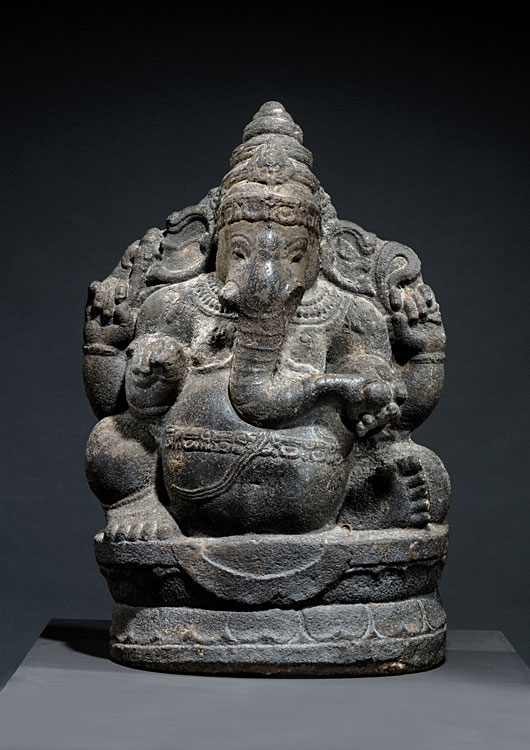

|
Ganesha India, Tamil Nadu Chola 11/12th century Granite height 95 cm. |

According to Hindu legend, Parvati was interrupted by Shiva as she bathed and so fashioned a son in the form of a youth from the scrapings of her skin and set him to guard her door. When Shiva returned the boy refused to let him in. In the struggle that followed, Shiva struck off the boys head. Enraged, Parvati insisted that Shiva replace her son's head, which he did with that of the first living being he saw an elephant. Ganesha is one of the most beloved of all the gods in the Hindu pantheon. As the deity who controls obstacles both their invention and removal he is invariably invoked before any major undertaking. Therefore he is considered as the god of auspiciousness and success, and the embodiment of wisdom. This image of Ganesha once graced a temple shrine. The deity is represented in a seated posture with his right knee raised and the sole of his left foot thrust forward. Each of his attributes the broken tusk in his lower right hand, the axe in his raised right hand, and the noose in his raised left hand is typically south Indian in style. In his fourth hand is a sweetmeat which he is scoops up with his trunk. The sculptor has emphasized the dwarfish aspect of the god by giving him an enormous belly and short legs. His divinity is underlined by the double lotus throne, the mukuta, the flowers above his ears and his jewellery, which includes a broad collar, bracelets, and anklets. A sacred cord crosses his body and his huge belly is girded by a handsome belt. The present Ganesha is a classic example of the Chola schools whose works are among the highlights of Indian civilization. The use of granite is typical of the stone sculpture of the period and it imbues the piece with a feeling of immortality. The broad collar, the shape of the mukuta, and the large lotus leaves on the throne are all typical stylistic characteristics. All forms are pronounced and full of energy. In contrast to later images the back of the piece is only roughly worked, as it was created to be seen from the front. A similar but smaller Chola sculpture of Ganesha is in the collection of the Los Angeles County Museum of Art [1]. A number of images dating from the middle Chola period are known in temples in south India [2]. This image of Ganesha is one of the largest examples known of its kind and it reveals the great skills of the Chola craftsmen. It is highly focused in shape, has a lively expression, radiates energetic power, and is complemented by a beautiful natural patina. All parts, including ears, trunk, arms, legs and fingers, are pronounced and rendered with a fine natural movement in striking contrast to the imposing volume of hard stone from which it has been so masterfully carved. [1] P. Pal, Indian Sculpture, Vol. 2, a catalogue of the Los Angeles County Museum of Art Collection, no 146a, The God Ganesha, Tamil Nadu, Chola 12th century, height 81.2 cm. [2] S. R. Balasubrahmanyam, Middle Chola Temples, Rajaraja I to Kulottunga I (985-1070), 1977, pl. 30, Tanjavur, Rajarajesvaram temple; pl. 45, Tiruchchengattangudi, Uttarapatisvarar temple; pl. 89, Tirunedunggalal, Tirunedunggalanathar temple; pl. 122, Esalam, Tiruvalisvarar temple; pl. 138, Kalakkattur, Agnisvarar temple; pl. 277, Panaiyavaram, Netroddharakasvamin temple; pl. 278, Kuvam, Tripurantakesvaram temple; and pl. 357, Vikkananampundi, Vijayalayasolisvaram temple. |